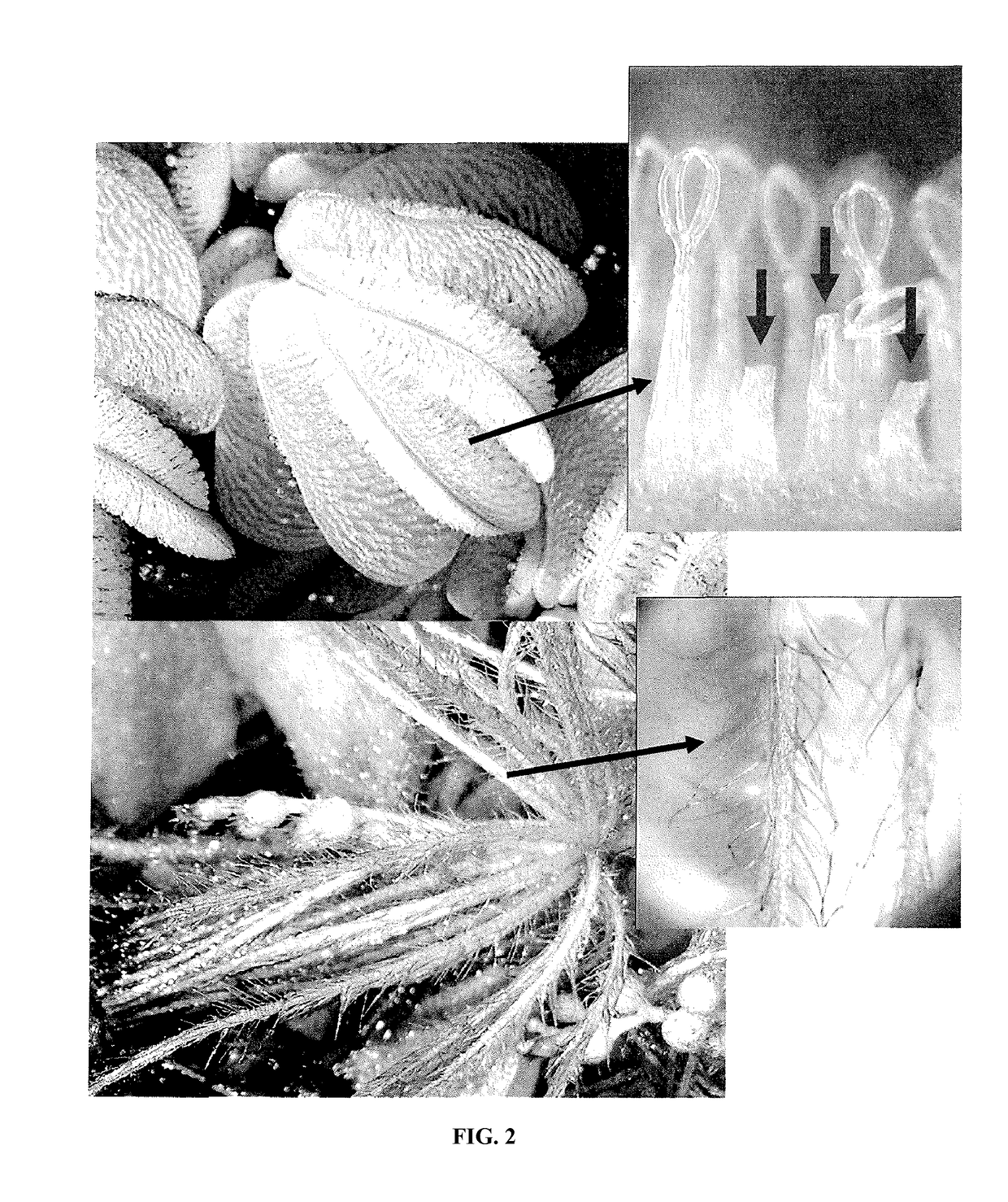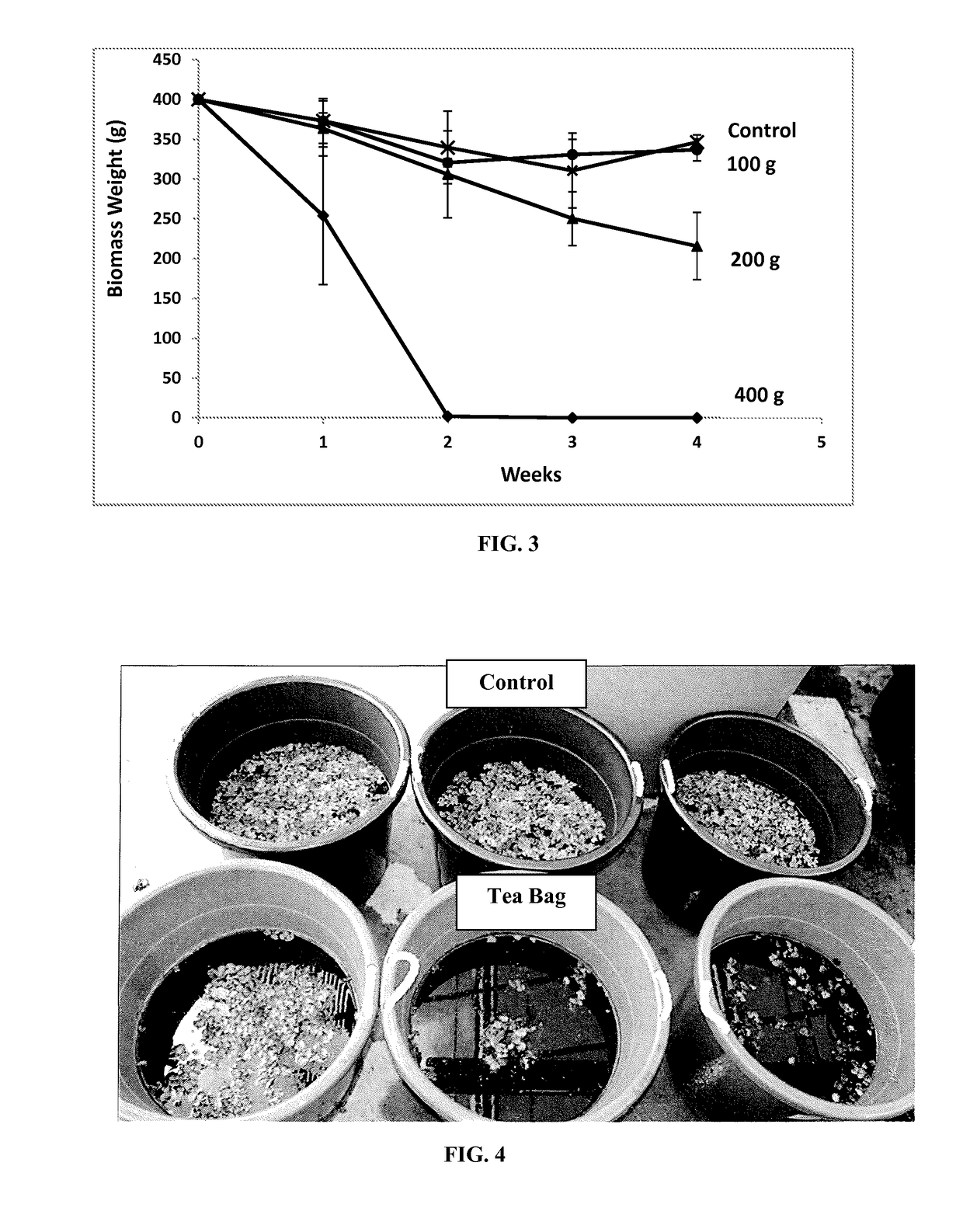Compositions and methods to selectively control invasive species
a technology of invasive species and endocrine system, applied in the field of biological and chemistry, can solve problems such as abnormal morphogenesis, and achieve the effect of effectively inhibiting invasive species
- Summary
- Abstract
- Description
- Claims
- Application Information
AI Technical Summary
Benefits of technology
Problems solved by technology
Method used
Image
Examples
example 1
Elimination and Prohibition of Giant Salvinia (Salvinia Molesta) by the Water-Extracted Dried Matters of Giant Salvinia
[0168]General Experimental Procedures:
[0169]Air-dried whole plants of giant salvinia were ground to a coarse powder and placed in nylon net bags (called “tea bags”). Each of 12 containers had 400 g of living healthy plants of giant salvinia in all growth stages (primary, secondary, and tertiary stages) in 25 L of tap water in the greenhouse (30° C. during the day time and 20° C. at night). Three containers had no treatment to serve as controls. The first treatment group had three containers and each had one bag of 100 g of giant salvinia dried matter in the water. The second group of three containers had one bag of 200 g of giant salvinia dried matter, and the last group of three containers had one bag of 400 g of giant salvinia dried matter. There was no significant difference of pH values between the treatments and control during the experiments.
[0170]Results:
[01...
example 2
Elimination and Prohibition of Giant Salvinia Plants by Water Extract of the Dried Matter of Giant Salvinia
[0172]General Experimental Procedures:
[0173]Air-dried whole plants (350 g) were ground to a coarse powder and percolated with H2O at RT to yield a 4 L aqueous solution (0.84%, g / mL). Of the aqueous solution, 119 mL was diluted to 900 mL 0.1% and 1,000 mL 0.01% solution (g / mL) for the following experiment. The experiment included 45 healthy and untreated living plants of giant salvinia (in secondary growth stage, approximately 7 g in fresh weight each). The plants were cultured and tested in plastic containers (14×15 cm, 0.68 L) in the NCPC Lab at RT. Controls: 15 plants with five in each container (3 replications) were cultured with 300 mL of tap water; 0.01% water extract treatment: 15 plants with five in each container (3 replications) were sprayed with 300 mL 0.01% of the water extract of giant salvinia dissolved in tap water; and 0.1% water extract treatment: 15 plants wit...
example 3
Elimination and Prohibition of Giant Salvinia Plants by Fractions of Water Extract of the Dried Matter of Giant Salvinia
[0176]General Experimental Procedures:
[0177]Air-dried whole plants of giant salvinia (1.4 kg) were ground to a coarse powder and extracted two times for 48 h with H2O (12 L×2) at RT. The combined H2O extracts were concentrated to give extracts (88 g) under reduced pressure. The H2O extracts was applied on a column of silica gel (1,000 g) eluting with the mixture of MeOH / CH2Cl2 (1:1, v / v, 3 L), 3 L of 100% MeOH, and 1 L H2O to obtain three fractions, respectively (FIG. 1). The water extract and three fractions were all prepared as experimental solutions at the concentration of 0.1%. The total 45 healthy and untreated living plants of giant salvinia (in secondary growth stage, approximately 10 g in fresh weight each) were cultured and tested in the plastic containers (14×15 cm, 0.68 L) in the NCPC Lab at RT. The five treatments are as follows. Controls: 9 plants wit...
PUM
 Login to View More
Login to View More Abstract
Description
Claims
Application Information
 Login to View More
Login to View More - R&D
- Intellectual Property
- Life Sciences
- Materials
- Tech Scout
- Unparalleled Data Quality
- Higher Quality Content
- 60% Fewer Hallucinations
Browse by: Latest US Patents, China's latest patents, Technical Efficacy Thesaurus, Application Domain, Technology Topic, Popular Technical Reports.
© 2025 PatSnap. All rights reserved.Legal|Privacy policy|Modern Slavery Act Transparency Statement|Sitemap|About US| Contact US: help@patsnap.com



